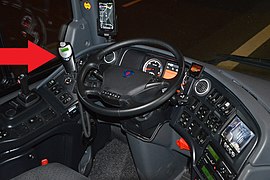
An ignition interlock device or breath alcohol ignition interlock device (IID or BAIID) is a breathalyzer for an individual's vehicle. It requires the driver to blow into a mouthpiece on the device before starting or continuing to operate the vehicle. If the resultant breath-alcohol concentration analyzed result is greater than the programmed blood alcohol concentration (which varies between countries), the device prevents the engine from being started. The interlock device is located inside the vehicle, near the driver’s seat, and is directly connected to the engine’s ignition system.[1] It is a form of electronic monitoring.
An ignition interlock interrupts the signal from the ignition to the starter until a valid breath sample is provided that meets maximal alcohol guidelines in that jurisdiction. At that point, the vehicle can be started as normal. A breath sample is not required to start the vehicle if the engine has been running within a time-out period, to allow quick re-starts in case the vehicle stalls. At random times after the engine has been started, the IID will require another breath sample, referred to as a rolling retest. The purpose of the rolling retest is to prevent someone other than the driver from providing a breath sample. If the breath sample isn't provided, or the sample exceeds the ignition interlock's preset blood alcohol level, the device will log the event, warn the driver, and then start up an alarm in accordance to state regulations (e.g., lights flashing, horn honking) until the ignition is turned off, or a clean breath sample has been provided. A common misconception is that interlock devices will simply turn off the engine if alcohol is detected; this would, however, create an unsafe driving situation and expose interlock manufacturers to considerable liability, which is why ignition interlock devices do not have an automatic engine shut off feature.
- ^ "Sober to Start". MADD. Archived from the original on 29 June 2017. Retrieved 29 June 2017.